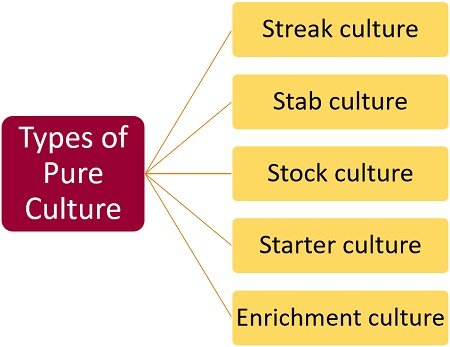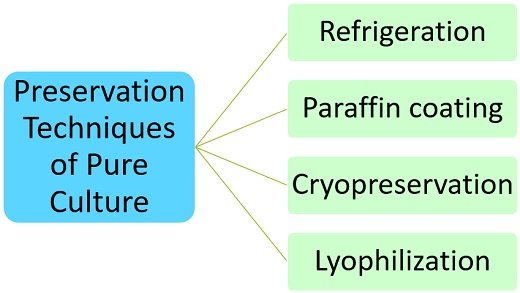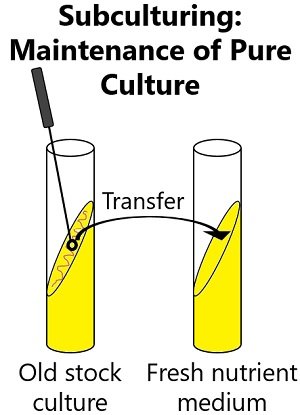A pure culture is derived from the solid nutrient medium containing a mixed microbial population. In simple words, pure culture refers to the isolation and culturing of the isolated colony from the mixed microbial population.
Isolation of a single colony or pure culturing is necessary to study the morphology and physiology of the microbial colony isolated from the mixed culture. Preservation and maintenance of the isolated colony are also important to enhance the viability of the microbial cell.
This post describes the definition, types and objectives of the pure culture method. Also, the standard preservation methods and maintenance of the pure culture have been explained.
Content: Maintenance and Preservation of Pure Culture
- Pure Culture Definition
- Types
- Purpose
- Assessment of Purity of Culture
- Preservation
- Maintenance
- Conclusion
Pure Culture Definition
Pure culture refers to an extensively used technique in the microbiological study of a single cell or single organism. Atmosphere possesses a mixed microbial population. Pure culture methods have been introduced to isolate a single colony from the mixed population. It involves the aseptic transfer of a single cell to the fresh nutrient agar medium.
Pure culturing of microorganisms preserves and revives the different characteristics of the microorganisms like shape, size and growth pattern. Before maintenance and preservation, isolation of the microbial culture is crucial.
Types
Pure culture merely refers to a distinct colony or cell growth without other contaminants and cell variants. Five forms of pure culture are summarized below:

- Streak culture isolates discrete colonies by streaking the little inoculum from the diluted microbial cell suspension.
- Stab culture uses an inoculating needle or earbud to stab the microbial culture down the middle of a test tube containing a solid nutrient medium.
- Stock culture maintains microorganism’s viability by subculturing a single microbial cell into a fresh medium.
- Starter culture is the preparation of the living organisms that initiate fermentation by changing the chemical composition of the substrates or raw materials.
- Enrichment culture isolates particular microbial cells or organisms of interest by providing favourable growth conditions.
Purpose
Pure culture technique aims at the following factors:
- It preserves the culture viability.
- Also, the pure culture method maintains the microbial cell characteristics.
- The preserved culture can be used for taxonomic studies or research purposes.
- It also provides an assay tool for vaccine designing and industrial production methods like enzymes and organic chemicals.
Assessment of Purity of Culture
- Isolated colonies in the pure culture possess the same size, texture, shape and colour.
- Under the microscope, they seem alike after staining.
- The isolated colonies give similar biochemical results.
Preservation of Pure Culture
As mentioned in the figure below, four standard techniques preserve various strains of microorganisms.

Refrigeration
The pure culture can be maintained or preserved under the refrigeration temperature of 0 to 4 °C. Slant cultures are prepared by streaking the discrete colony of interest from the solid nutrient medium.
Refrigerators preserve the bacterial culture for upto 2-3 weeks and a fungal culture for 3-4 months. The refrigeration temperature greatly slows down the metabolic activity of the organisms but does not stop it completely.
Thus, the microbes slowly utilize the nutrient medium, increase in number and finally die due to the nutrient scarcity and accumulation of toxic wastes. The downside of refrigerated microbial culture is that the cells are preserved for a short time.
Paraffin Coating
It is a method of overlaying microbial culture with mineral oil or paraffin. Mineral oil should be added upto the height of the slant so that it fully covers the microbial growth. The paraffin coating method preserves the cell culture for approximately 1-2 years. It is a simple and less expensive technique.
One needs to store the slant cultures with sterile liquid paraffin vertically at room temperature. Liquid paraffin maintains the moisture content of the nutrient medium. It also maintains anaerobic conditions.
Thus, a layer of paraffin maintains the dormant state of the bacterial and fungal cells for several years. It is an economical method to preserve microbial cells for a more extended period.
Cryopreservation
It preserves the dense suspension of microbial culture by employing cryopreservative agents like glycerol and dimethyl sulfoxide. The cryopreservation method uses small vials or ampoules to preserve the microbial culture at an extremely low temperature.
Liquid nitrogen freezers and mechanical cryogenic freezers are the two kinds of cryo freezers. Liquid nitrogen freezers preserve cell culture in the liquid or vapour phase (of liquid nitrogen) at a freezing temperature of -196 °C.
Conversely, mechanical cryogenic freezers maintain the cell culture viability at -150 °C. Cryopreservative agents serve as stabilizing agents that maintain the cell culture by preventing ice crystal formation. The cell viability under cryopreservation is between 10 to 30 years.
It preserves the microbial cell of interest that could not be preserved under lyophilization. It is quite an expensive method. Factors like the type of microbial cell, choice of the cryoprotectant, rates of cooling and thawing decide cryopreservation effectiveness. Cryopreservation is comparatively easy in the long term preservation of the microbial cells than lyophilization.
Lyophilization
Freeze-drying or lyophilization also preserves a dense cell suspension of microbial culture. Unlike cryopreservation, it uses lyoprotectant (usually sucrose) to stabilize the microbial cell culture. The freeze-drying method requires the collection of the microbial cell suspension in small vials.
In the lyophilization method, one needs to freeze the cell culture at a temperature between -60 to -78 °C. Then, subject the cell culture to sublimation that dehydrates the moisture content of the microbial sample by vacuuming.
It causes minor distortion to the microbial cell structures and maintains cell viability for a longer time (more than 30 years). The lyophilized cultures cover minimum storage space. The transportation of small vials to other labs or collection centres becomes easy.
Nevertheless, lyophilized cultures do not require special handling. It is a cost-effective method that requires special equipment and reagents. The downside of the lyophilization method is that it requires optimization for each strain, as the method does not work in the same way.
Maintenance of Pure Culture
Subculturing is the best way to maintain pure culture viability. It involves the systemic transfer of little inoculum from the pure old culture to the fresh nutrient agar slants. Stock culture is prepared periodically from the previous stock culture.

Subculturing merely refers to the passaging of cells. The subculturing of suspended bacteria and fungi refers to the subculturing of non-adherent cells or suspension cells. Non-adherent microorganisms grow in solutions and remain unattached to a surface.
Thus, the subculturing of non-adherent cells involves diluting a small volume of the old stock culture in a new growth medium. It enables cell line propagation. However, it fails to maintain the characteristics of a strain due to the development of variants and mutants.
Conclusion
Therefore, we can conclude that biopreservation plays a pivotal role in maintaining cell integrity, functioning, and characteristics. We could use different preservation methods for different microbial strains. Thus, culture preservation effectively maintains the cells in a dormant state by avoiding the growth of contaminants and variants.
This is awesome. Thanks!
Amazing!!